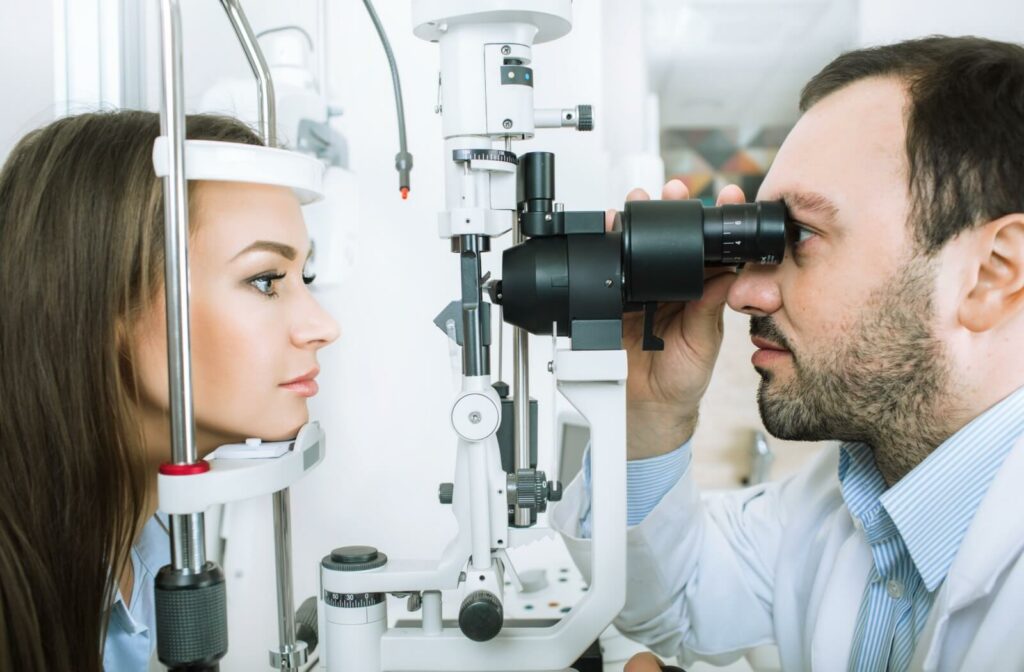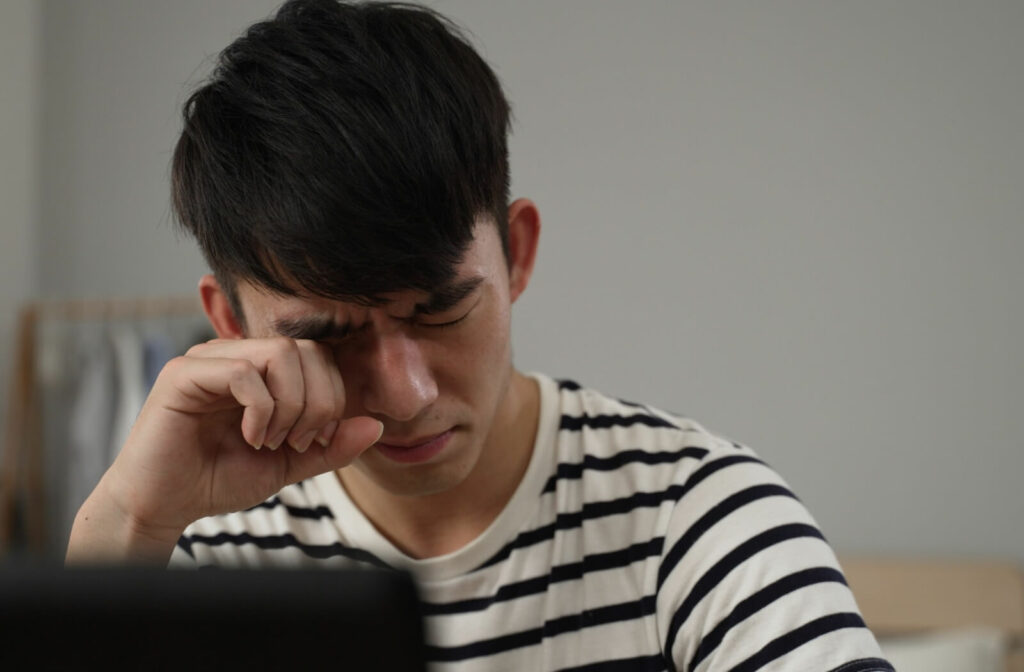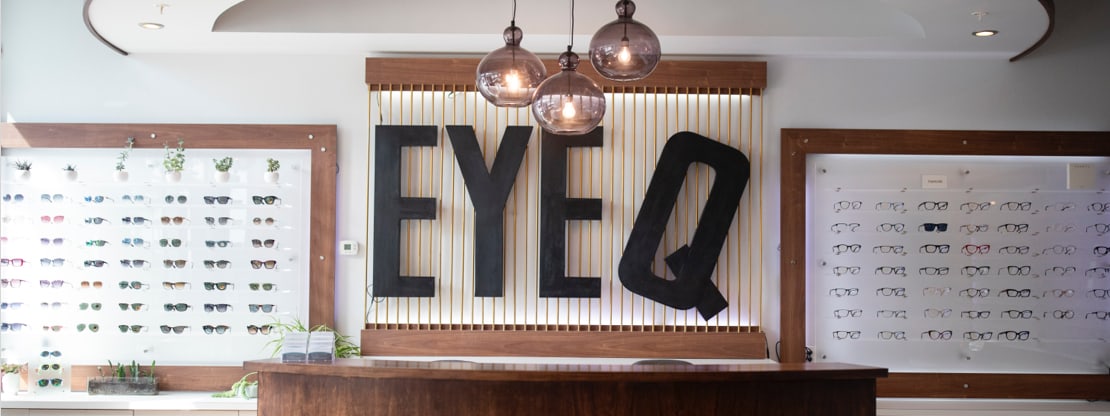Dry eye syndrome is a common condition that affects many people at some point in their lives. This condition occurs when there’s an issue with your tears—either your eyes don’t produce enough of them, or the tears they do produce are of poor quality. This lack of proper lubrication can lead to uncomfortable symptoms, such as irritation and blurry vision.
Can dry eye syndrome cause blindness? While it’s rare for dry eyes to result in complete blindness, untreated severe cases can lead to significant vision problems. Chronic dry eye can increase the risk of complications like infections, corneal abrasions, and, in extreme instances, vision impairment.
If you notice any symptoms of dry eye, don’t wait—reach out to Eye Q Optometry for a comprehensive eye exam and get recommendations for treatment. Taking action early can help reduce the risk of serious eye damage or vision loss related to chronic dry eye syndrome.
How Severe Dry Eye May Impact Vision
Although dry eyes are unlikely to cause blindness, severe cases can result in complications that may affect vision. The key factor here is the severity of the condition. For most people, dry eye symptoms are mild to moderate—irritating but not threatening to eyesight.
However, in rare instances where dry eye syndrome becomes severe and remains untreated, it can damage the cornea. The cornea, the transparent front layer of the eye, plays a crucial role in focusing light so that you can see clearly. If the cornea is damaged, this can lead to blurred vision and, in extreme circumstances, vision loss.
Dry Eye Linked to Underlying Health Conditions
Severe dry eye caused by autoimmune conditions like Lupus or Sjögren’s syndrome can result in lasting damage to the cornea, compromising vision clarity. Persistent irritation may also lead to scarring, which can progress to partial or even complete vision loss.
Dry Eye Related to Medications & Procedures
Certain medications can also contribute to dry eyes, potentially impacting your ability to see clearly. For example, drugs used for Parkinson’s, hypertension, allergies, depression and some treatments for acne can reduce tear production, eventually leading to dryness and corneal damage.
Additionally, prolonged use of contact lenses or undergoing LASIK surgery with an existing dry eye condition can make dryness worse, raising the risk of infections or potential vision impairment.
Recognizing the Signs of Dry Eye
Dealing with dry eyes can be quite uncomfortable. Typical signs of dry eye include stinging, burning, or gritty feeling in your eyes. You might also notice mucus in your eyes, increased sensitivity to light, redness, or the sensation that something is stuck in your eyes.
For some people, blurry vision or eye fatigue may also occur. It’s worth noting that symptoms can differ from one person to another. If you’re experiencing any discomfort or changes in your vision, it’s always a good idea to consult with an eye care professional for proper guidance.
You can take a quick Dry Eye Quiz to learn more about your symptoms and find out if it’s time to seek professional help.

Treating Dry Eye
Dry eye syndrome can significantly affect your day-to-day comfort and vision quality. Finding the right approach to treatment is essential, as this condition often stems from a variety of causes, including poor tear quality, environmental factors, medical conditions, or even prolonged digital screen use.
Dry Eye Therapies
- Artificial tears: Artificial tears provide quick relief by replenishing moisture. At Eye Q Optometry, we offer guidance on choosing between watery or gel-based drops, depending on your condition’s severity and personal preference.
- BlephEx: This in-office treatment addresses blepharitis, a condition that can exacerbate dry eye. By exfoliating the eyelids and removing bacteria and debris, it not only soothes irritation but also promotes healthier tears.
- 20-20-20 rule: For those suffering from digital eye strain, this simple rule can make a big difference. Take a break every 20 minutes to focus on an object 20 feet away for 20 seconds to ease eye strain and dryness.
- Medicated Eye Drops: Prescription eye drops can be an option for treating dry eye syndrome, providing tailored treatment and symptom relief.
- Eye nutrition: Omega-3 fatty acids from foods or supplements can help reduce inflammation and support the production of the oily layer of tears, improving tear quality.
- Heat masks: Warm compresses or ready-made heat masks can improve circulation, ease eyelid inflammation, and unblock tear glands, offering soothing relief for chronic dryness.
- Lid hygiene: Maintaining clean eyelids is crucial for reducing bacteria and debris that can worsen symptoms. Eyelid wipes or a gentle hypochlorous acid spray can help keep your eyes healthy and comfortable.
- Punctal plugs: These small devices are inserted into your tear ducts to slow tear drainage and keep your eyes moisturized longer. Available as temporary or semi-permanent treatments, punctal plugs are often an effective solution for more severe cases of dry eye.
- Sunglasses: Wind, dust, and UV rays can intensify dry eye symptoms. Sunglasses provide a barrier against these irritants, while also protecting the eyes from sun damage.
Prioritize Your Eye Health With Dry Eye Care
While the idea of dry eyes leading to blindness can seem alarming, it’s important to remember that this is extremely rare and typically only happens in severe, untreated cases.
The best way to avoid serious complications from dry eye syndrome is by scheduling regular eye exams and following your eye care professional’s recommendations for managing your symptoms.
With the right care and treatment, dry eye syndrome can be effectively managed, helping you maintain healthy vision. Stay proactive about your eye health, and if you notice any changes or discomfort, don’t hesitate to seek expert advice from Eye Q Optometry. Book your appointment today!










